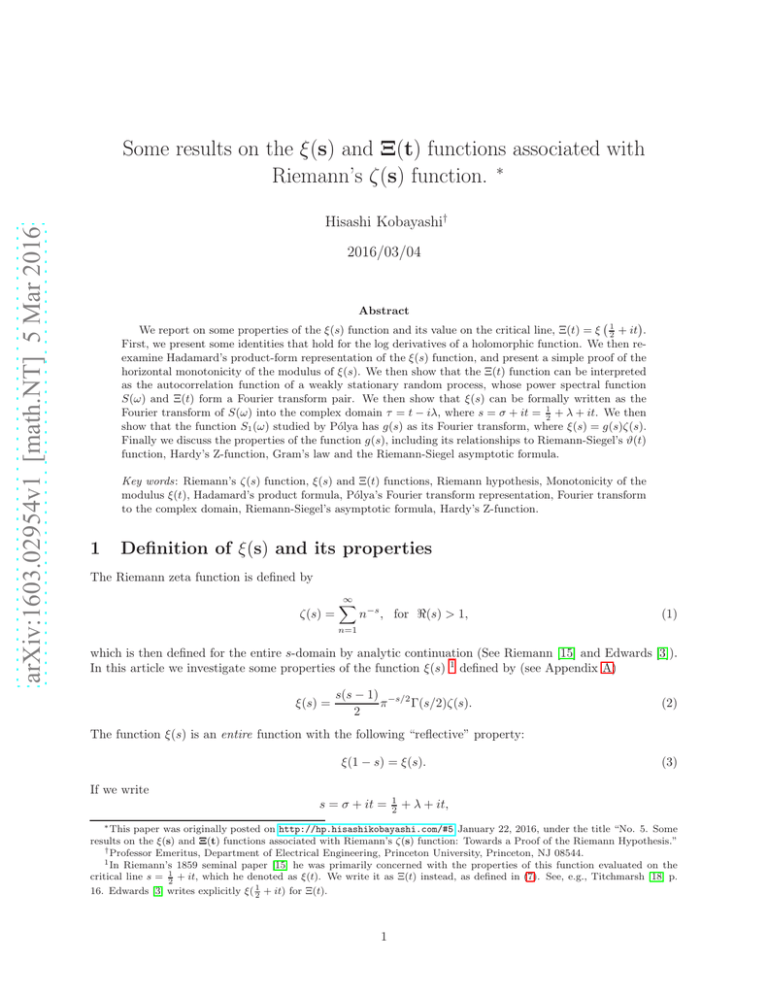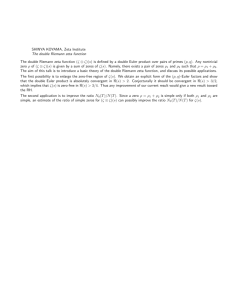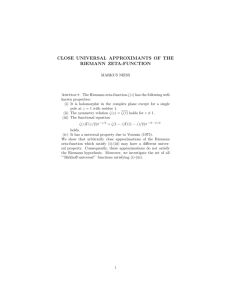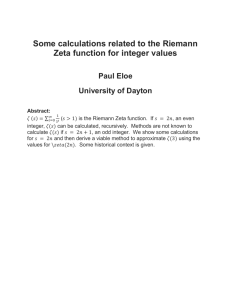Some results on the $\ xi (s) $ and $\ Xi (t) $ functions associated
advertisement

arXiv:1603.02954v1 [math.NT] 5 Mar 2016
Some results on the ξ(s) and Ξ(t) functions associated with
Riemann’s ζ(s) function. ∗
Hisashi Kobayashi†
2016/03/04
Abstract
We report on some properties of the ξ(s) function and its value on the critical line, Ξ(t) = ξ 21 + it .
First, we present some identities that hold for the log derivatives of a holomorphic function. We then reexamine Hadamard’s product-form representation of the ξ(s) function, and present a simple proof of the
horizontal monotonicity of the modulus of ξ(s). We then show that the Ξ(t) function can be interpreted
as the autocorrelation function of a weakly stationary random process, whose power spectral function
S(ω) and Ξ(t) form a Fourier transform pair. We then show that ξ(s) can be formally written as the
Fourier transform of S(ω) into the complex domain τ = t − iλ, where s = σ + it = 12 + λ + it. We then
show that the function S1 (ω) studied by Pólya has g(s) as its Fourier transform, where ξ(s) = g(s)ζ(s).
Finally we discuss the properties of the function g(s), including its relationships to Riemann-Siegel’s ϑ(t)
function, Hardy’s Z-function, Gram’s law and the Riemann-Siegel asymptotic formula.
Key words: Riemann’s ζ(s) function, ξ(s) and Ξ(t) functions, Riemann hypothesis, Monotonicity of the
modulus ξ(t), Hadamard’s product formula, Pólya’s Fourier transform representation, Fourier transform
to the complex domain, Riemann-Siegel’s asymptotic formula, Hardy’s Z-function.
1
Definition of ξ(s) and its properties
The Riemann zeta function is defined by
ζ(s) =
∞
X
n=1
n−s , for ℜ(s) > 1,
(1)
which is then defined for the entire s-domain by analytic continuation (See Riemann [15] and Edwards [3]).
In this article we investigate some properties of the function ξ(s) 1 defined by (see Appendix A)
ξ(s) =
s(s − 1) −s/2
π
Γ(s/2)ζ(s).
2
(2)
The function ξ(s) is an entire function with the following “reflective” property:
ξ(1 − s) = ξ(s).
(3)
If we write
s = σ + it =
1
2
+ λ + it,
∗ This paper was originally posted on http://hp.hisashikobayashi.com/#5 January 22, 2016, under the title “No. 5. Some
results on the ξ(s) and Ξ(t) functions associated with Riemann’s ζ(s) function: Towards a Proof of the Riemann Hypothesis.”
† Professor Emeritus, Department of Electrical Engineering, Princeton University, Princeton, NJ 08544.
1 In Riemann’s 1859 seminal paper [15] he was primarily concerned with the properties of this function evaluated on the
critical line s = 12 + it, which he denoted as ξ(t). We write it as Ξ(t) instead, as defined in (7). See, e.g., Titchmarsh [18] p.
16. Edwards [3] writes explicitly ξ( 21 + it) for Ξ(t).
1
the property (3) is paraphrased as
By setting λ = 0 in (5), we find
ℜ ξ
ℑ ξ
1
2
1
2
= ℜ ξ 21 − λ + it ,
+ λ + it = −ℑ ξ 21 − λ + it ,
+ λ + it
ℑ ξ
1
2
+ it
= 0, for all t,
which implies that ξ(s) is real on the “critical line.” Thus, if we define a real-valued function
Ξ(t) = ξ 12 + it = ℜ ξ 12 + it ,
(4)
(5)
(6)
(7)
the Riemann hypothesis can be paraphrased as “The zeros of Ξ(t) are all real,” which is indeed the way
Riemann stated his conjecture, now known as the Riemann hypothesis or RH for short.
By applying Laplace’s equation to ℑ {ξ(s)} and using (6), we readily find
∂ 2 ℑ {ξ(s)} = 0.
(8)
∂λ2
λ=0
Thus, it follows that ℑ {ξ(s)} must be a polynomial in λ of degree 1 in the vicinity of λ = 0, viz.,
ℑ {ξ(s)} ≈ b(t)λ, for λ ≈ 0,
(9)
where b(t) is a function of t only, independent of λ.
Similarly, by applying Laplace’s equation to ℜ {ξ(s)} and using the Cauchy-Riemann equation:
∂ℜ {ξ(s)}
∂ℑ {ξ(s)}
=−
.
∂t
∂λ
(10)
and using (9), we find that the real part of ξ(s) is a polynomial in λ of degree 2:
ℜ {ξ(s)} ≈
where b′ (t) =
2
b′ (t) 2
λ , for λ ≈ 0,
2
(11)
db(t)
.
dt
Preliminaries
2.1
Logarithmic Differentials of Holomorphic Functions
We begin with the following lemma that is applicable to any holomorphic function.
Lemma 2.1. For a holomorphic function f (s) we have
1
|f (s)|
1
|f (s)|
wherever f (s) 6= 0, where f ′ (s) =
′ ∂|f (s)|
f (s)
,
·
=ℜ
∂σ
f (s)
′ ∂|f (s)|
f (s)
,
·
= −ℑ
∂t
f (s)
(12)
(13)
df (s)
.
ds
Proof. See Kobayashi [8].
By differentiating the logarithm of f (s) further, we obtain
c
Hisashi
Kobayashi, 2016.
2
Corollary 2.1. For the holomorphic function f (s) of Lemma 2.1 the following identities also hold:
(
2
′ 2 )
1 ∂ 2 |f (s)|
1 ∂|f (s)|
f ′′ (s)
f (s)
,
−
−
=ℜ
|f (s)| ∂σ 2
|f (s)| ∂σ
f (s)
f (s)
(
2
′ 2 )
f ′′ (s)
1 ∂|f (s)|
f (s)
1 ∂ 2 |f (s)|
.
= −ℜ
−
−
|f (s)| ∂t2
|f (s)| ∂t
f (s)
f (s)
wherever f (s) 6= 0, where f ′′ (s) =
(14)
(15)
d2 f (s)
.
ds2
Proof. See Kobayashi [8].
2.2
The Product Formula for ξ(s)
Hadamard [5] obtained in 1893 the following product-form representation
Y s
ξ(s) = 21 eBs
es/ρn ,
1−
ρn
n
(16)
using Weirstrass’s factorization theorem, which asserts that any entire function can be represented by a
product involving its zeroes. In (16), the product is taken over all (infinitely many) zeros ρn ’s of the function
ξ(s), and B is a real constant. Detailed accounts of this formula are found in many books (see e.g., Edwards
[3], Iwaniec [7] Patterson [13] and Titchmarsh [18]). Sondow and Dumitrescu [16] and Matiyasevich et al.
[11] explored the use of the above product form, hoping to find a possible proof of the Riemann hypothesis.
By taking the logarithm of (16) and differentiating it, we obtain
X 1
1
ξ ′ (s)
.
(17)
+
=B+
ξ(s)
s − ρn
ρn
n
From the definition of ξ(s) in (2), we have
ξ ′ (s)
ζ ′ (s)
1
1
log π
= +
−
+ Ψ( 2s ) +
,
ξ(s)
s s−1
2
ζ(s)
(18)
where
Ψ(s) =
Γ′ (s)
Γ(s)
is the digamma function.
We equate (17) to (18), use the identity Ψ( 2s + 1) = 1s + 12 Ψ( 2s ), and set s = 0, obtaining
X 1
1
ζ ′ (0)
= −1 − 12 + 21 Ψ(1) +
−
+
.
B+
ρn
ρn
ζ(0)
n
(19)
By using ζ ′ (0)/ζ(0) = log(2π), and Ψ(1) = Γ′ (1) = −γ (where γ = 0.5772218 . . . is the Euler constant), we
determine the constant B as
B = log(2π) − 1 −
1
2
log π − γ/2 =
1
2
log(4π) − 1 − γ/2 = −0.0230957 . . . .
(20)
Davenport ([1] pp. 81-82) derives an alternative expression for B. The reflective property of ξ(s) gives
the identity
ξ ′ (1 − s)
ξ ′ (s)
=−
,
ξ(s)
ξ(1 − s)
c
Hisashi
Kobayashi, 2016.
(21)
3
which, together with (17), yields
B+
X
n
1
1
+
s − ρn
ρn
= −B −
X
n
1
1
+
1 − s − ρn
ρn
.
(22)
Thus,
X 1
1
−
B=−
ρ
2
n
n
X
n
X
1
1
−
s − ρn
s
−
(1
− ρn )
n
!
∞
X 1
X
σn
=−
= −2
,
2 + t2
ρ
σ
n
n
n
n=1 n
(23)
Note that the two summed terms in the parenthesis in the first line of the above cancel to each other, because
if ρn is a zero, so is 1 − ρn . To obtain the final expression in the above, we use the property that when
ρn = σn + itn is a zero, so is its complex conjugate ρ∗n = σn − itn , thus we enumerate zeros in such a way
that ρ∗n = ρ−n .
By substituting (23) back into (16), we obtain
!
Y
X 1 Y
s
s
1
e−s/ρn 1 −
1−
es/ρn = 12
es/ρn
ξ(s) = 2 exp −s
ρ
ρ
ρ
n
n
n
n
n
n
Y
s
.
(24)
1−
= 21
ρn
n
This is nothing but the product form
Y
s
1−
ξ(s) = ξ(0)
,
ρn
n
which Edwards (see [3] p. 18 and pp. 46-47) attributes to Riemann.
Then, Eqn.(17) is simplified to
ξ ′ (s) X 1
.
=
ξ(s)
s − ρn
n
(25)
From this and Lemma 2.1, we have
X 1
1 ∂|ξ(s)|
=ℜ
|ξ(s)| ∂σ
s − ρn
n
!
=
X
n
σ − σn
.
(σ − σn )2 + (t − tn )2
(26)
Thus, we arrive at the following theorem concerning the monotonicity of the |ξ(s)| function, which Sondow
and Dumitrescu [16] proved in a little more complicated way based on (16) instead of (24). Matiyaesevich
et al. [11] also discuss the monotonicity of the ξ(s) and other functions.
Theorem 2.1 (Monotonicity of Modulus Function |ξ(s)|). Let σsup be the supremum of the real parts of all
zeros:
σsup = sup{σn }.
n
Then the modulus |ξ(σ + it)| is a monotone increasing function of σ in the region σ > σsup for all real t.
Likewise, the modulus is a monotone decreasing function of σ in the region σ < σinf , where
σinf = inf {σn } = 1 − σsup .
n
Proof. It is apparent from (26) that |ξ(s)| is a monotone increasing function of σ in the range σ > σsup ≥ 21
for all t. Because of the reflective property (3) it then readily follows that |ξ(s)| is a monotone decreasing
function of σ in the range σ < 1 − σsup ≤ 12 .
c
Hisashi
Kobayashi, 2016.
4
Thus, if all zeta zeros are located on the critical line, i.e., if σsup = σinf = 12 , the derivative of the modulus
|ξ(s)| is positive for σ > 21 , and negative for σ < 12 . Thus, we have shown the necessity of monotonicity of the
modulus function |ξ(s)|, which has been one of major concerns towards a proof of the Riemann hypothesis.
Corollary 2.2 (Monotonicity of Modulus Function |ξ(s)|, if the Riemann hypothesis is true). If all zeta
zeros are on the critical line, the modulus |ξ(σ + it)| is a monotone increasing function of σ in the right half
plane, σ > 12 . Likewise, the modulus is a monotone decreasing function of σ in the left half plane, σ < 21 .
Proof. The above discussion that has led to this corollary should suffice as a proof.
2.3
Functions a(λ, t), b(λ, t), α(λ, t), β(λ, t) and Their Properties
Take the imaginary part of both sides of (25) and set s = 21 + it. By noting that ξ(s) is real for σ = 12 , we
obtain
X
t − tn
1 ∂ℑ(ξ(s)) .
(27)
=
2
1
ξ(s)
∂σ
(t − tn ) + ( 12 − σn )2
σ=
n
2
Recall the function b(t) defined in (9). Then, the LHS of the above is
b(t)
, where
Ξ(t)
1
1Y
+ it
1− 2
+ it =
2 n
σn + itn
X
∂ℑ {ξ(s)} t − tn
b(t) =
.
= Ξ(t) ·
2
1
∂σ
(t − tn ) + ( 12 − σn )2
σ=
n
Ξ(t) = ξ
1
2
(28)
(29)
2
Differentiate (25) once more, and we obtain
which can be rearranged to yield
X
1
ξ ′′ (s)ξ(s) − ξ ′ 2 (s)
,
=
−
ξ 2 (s)
(s
−
ρn )2
n
ξ ′′ (s)
=
ξ(s)
ξ ′ (s)
ξ(s)
2
−
X
n
1
.
(s − ρn )2
Taking the real part of both sides, and evaluating them at s = 21 + it, we find
2 X
(t − tn )2 − ( 21 − σn )2
b(t)
2a(t)
+
=−
1
2
Ξ(t)
Ξ(t)
( − σn )2 + (t − tn )2
n
(30)
2
−b2 (t)2 + b′ (t)Ξ(t) − b(t)Ξ′ (t)
.
=
Ξ2 (t)
(31)
where
∂ 2 ξ(s) 2a(t) =
.
∂σ 2 σ= 1
(32)
2
From the Cauchy-Riemann equation we find
∂ℑ {ξ(s)} Ξ (t) = −
1 = −b(t).
∂σ
σ=
′
(33)
2
By substituting this into (31), we obtain a surprisingly simple result:
a(t) = 12 b′ (t) = − 21 Ξ′′ (t),
(34)
which can be alternatively obtained by applying the Laplace equation to (32).
The above formulae carry over to any point s = 21 + λ + it:
c
Hisashi
Kobayashi, 2016.
5
Lemma 2.2. Let us define
∂ 2 ℜ {ξ(s)}
= −ℜ {ξ ′′ (t)} ,
∂λ2
∂ℑ {ξ(s)}
,
b(λ, t) =
∂λ
2a(λ, t) =
(35)
(36)
where ξ ′′ (s) is the second partial derivative of ξ(s) with respect to t. Then, the following relations hold:
a(λ, t) = 21 b′ (λ, t),
′
b(λ, t) = −ℜ {ξ (t)}
(37)
(38)
Proof. By applying the Cauchy-Riemann equations and Laplace’s equation, the above relations can be easily
derived.
We now derive similar functions and their relations by interchanging ℜ {ξ(s)} and ℑ {ξ(s)}.
Corollary 2.3. Let us define
∂ 2 ℑ {ξ(s)}
= −ℑ {ξ ′′ (s)} ,
∂λ2
∂ℜ {ξ(s)}
.
β(λ, t) =
∂λ
2α(λ, t) =
(39)
(40)
Then the following relations hold:
α(λ, t) = − 12 β ′ (λ, t),
β(λ, t) = ℑ {ξ ′ (s)} .
∂a(λ, t)
= α′ (λ, t),
∂λ
∂β(λ, t)
= b′ (λ, t),
∂λ
(41)
(42)
∂α(λ, t)
= −a′ (λ, t)
∂λ
∂b(λ, t)
= −β ′ (λ, t).
∂λ
(43)
(44)
Proof. By applying the Cauchy-Riemann equations and Laplace’s equation, the above relations can be easily
derived.
3
The Fourier transform representation of ξ(s)
3.1
Integral representation of ξ(s)
We begin with the following integral representation of ξ(s) (see Appendix A) found in Edwards [3], p.16.
Z
dx
1 s(1 − s) ∞
,
(45)
ξ(s) = −
ψ(x) xs/2 + x(1−s)/2
2
2
x
1
where
ψ(x) =
∞
X
2
e−n
πx
(46)
n=1
is called the theta function. By applying integration by parts to (45) and Jacobi’s identity for the theta
function2 Edwards ([3], p. 17) gives the following expression by generalizing Riemann’s result, which holds
for any complex number s:
Z ∞
d[x3/2 ψ ′ (x)] −1/4
x
cosh 12 s − 12 log x dx.
ξ(s) = 4
(48)
dx
1
2 Jacobi’s
identity for the theta function ψ(x) is
2ψ(x) + 1 = x−1/2 2ψ(x−1 ) + 1 .
c
Hisashi
Kobayashi, 2016.
(47)
6
By writing
d[x3/2 ψ ′ (x)] −1/4
x
= πx1/4 D(x)
dx
(49)
with D(x) defined by
D(x) =
∞
X
n=1
2
n2 (n2 πx − 32 )e−n
πx
> 0, for x ≥ 1,
(50)
we can write (48) as
ξ(s) = 4π
Z
∞
1/4
x
1
D(x) cos
τ log x
2
dx,
(51)
where τ is a complex number defined by
τ = t − iλ = −i(s − 21 ),
(52)
and we used the identity cosh(iy) = cos y. By changing the variable from x to ω by
log x
, x ≥ 1,
2
ω=
(53)
and defining
S(ω) = 8πe5ω/2 D(e2ω ), ω ≥ 0
(54)
we can write (51) as
ξ(s) =
Z
∞
S(ω) cos(ωτ ) dω,
(55)
0
which is a compact expression for
ξ( 21
On the critical line s =
1
2
+ λ + it) =
Z
∞
S(ω) (cos ωt cosh(ωλ) + i sin ωt sinh(ωλ)) dω.
(56)
0
+ it (i.e., when λ = 0), the above reduces to a more familiar formula
Z ∞
Ξ(t) =
S(ω) cos(ωt) dω.
(57)
0
3.2
The kernel function S(ω) as a power spectral function.
The kernel S(ω) defined by (54) is positive for all ω ≥ 0, because D(x) is positive for x ≥ 1. Therefore,
S(ω) can qualify as a spectral density function of a certain wide-sense stationary (a.k.a. weakly stationary)
process, and we can interpret Ξ(t) as its autocorrelation function (see e.g., [10] p. 349). In this context,
the Fourier transforms between the spectrum S(ω) and the function Ξ(t) are what is known as the WienerKhinchin theorem (a.k.a. the Wiener-Khinchin-Einstein theorem). The inverse transform to (57), given
below by (61), exists when Ξ(t) is absolutely integrable.
The Fourier transform representation (57) has been studied by George Pólya [14] and others (see e.g.,
Titchmarsh [18], Chapter 10). Dimitrov and Rusev [2] give a comprehensive review of the past work on
“zeros of entire Fourier transforms,” including Pólya’s work.
From the above observation that S(ω) is positive for ω ≥ 0, we can readily establish the following
proposition:
c
Hisashi
Kobayashi, 2016.
7
Theorem 3.1. The modulus |Ξ(t))| is maximum at t = 0, i.e.,
|Ξ(t)| ≤ Ξ(0) = 0.4971 . . . , for all t.
(58)
Furthermore,
Z
∞
Ξ(t) dt = 3π
0
Proof. From (55), it readily follows that
Z
|Ξ(t)| ≤
0
π 1/4
−1
Γ(3/4)
∞
|S(ω)| dω =
Z
= 2.8067 . . . .
(59)
S(ω) dω = Ξ(0).
(60)
∞
0
Since ζ( 12 ) = −1.46035 . . .3 , and g( 21 ) = − 81 π −1/4 Γ( 14 ) = −0.3404 . . ., we have Ξ(0) = ξ( 12 ) = g( 21 )ζ( 12 ) =
0.4971 . . ..
From the Wiener-Khinchin inverse formula, which holds when Ξ(t) is absolutely integrable, we have
Z
2 ∞
Ξ(t) cos(ωt) dt.
(61)
S(ω) =
π 0
By setting ω = 0, we readily find
2
S(0) =
π
Z
∞
Ξ(t) dt.
(62)
0
By setting ω = 0 in (54), we have
S(0) = 8πD(1) = 8
3 ′
2 ψ (1)
+ ψ ′′ (1) .
(63)
The function ψ(x) satisfies the aforementioned Jacobi’s identity (47). By differentiating the identity equation,
we find
2ψ ′ (x) = − 21 x−3/2 − x−3/2 ψ(1/x) − 2x−5/2 ψ ′ (1/x)
(64)
By setting x = 1 in (64) we obtain
ψ ′ (1) = − 81 (1 + 2ψ(1))
(65)
(66)
The value of ψ(1) is known (see e.g., Yi [19], Theorem 5.5 in p. 398)
1/4
π
1.3313
1
1
ψ(1) = 2
−1 = 2
− 1 = 0.0432 . . . .
Γ(3/4)
1.2254
(67)
Hence,
ψ ′ (1) = − 81
π 1/4
= −0.1358 . . . .
Γ(3/4)
(68)
The numerical evaluation of ψ ′′ (1) is straightforward, since its series representation converges rapidly:
ψ ′′ (1) = π 2
∞
X
n=1
2
n4 e−πn ≈ π 2
2
X
2
n4 e−πn = 0.4271 . . . .
(69)
n=1
Thus, we finally evaluate
Z
∞
Ξ(t) dt =
0
3 See
π
S(0) = 4π
2
3 ′
2 ψ (1)
+ ψ ′′ (1) = 2.8067 . . .
(70)
e.g. https://oeis.org/A059750 .
c
Hisashi
Kobayashi, 2016.
8
The variable t of the complex variable s = σ + it = 12 + λ + it is often called the height in the zeta function
related literature. In view of the Wiener-Khinchin theorem (57) and (61), it may be appropriate to interpret
t as “time” and the variable ω of S(ω) as the “(angular) frequency.” Then, we may refer to the complex
number τ defined by (52) as “complex-time.” Use of the complex-time τ allow the compact representation
(55) given earlier, viz.
Z ∞
ξ(s) =
S(ω) cos(ωτ ) dω.
(71)
0
This interpretation of Riemann’s result (48) will shed some new light to the Fourier transform representation
of the ξ(s) function. We will further discuss this in a later section.
4
Further results on the Fourier transform representation
4.1
Decomposition of S(ω)
In the Fourier transform representation (55) the kernel function S(ω) can be expressed as
∞
X
S(ω) =
Sn (ω),
(72)
n=1
with
Sn (ω) = 8πe5ω/2 Dn (e2ω ),
(73)
where
2
Dn (x) = n2 (n2 πx − 32 )e−n
πx
.
(74)
The Fourier transform can therefore be written as a summation of infinite components, i.e.,
ξ(s) =
∞
X
fn (s),
(75)
n=1
with
fn (s) =
Z
∞
Sn (ω) cos(ωτ ) dω
0
= 8π
Z
∞
e5ω/2 Dn (e2ω ) cos(ωτ ) dω.
(76)
0
The switching in the order between the summation over n and the integration over ω, as used in (76) and
N
X
(75), can be justified, because the series
Sn (ω) uniformly converges to S(ω) as N → ∞ in the entire
n=1
range ω ≥ 0. Note also that in the range ω ≥ 0, S(ω) is predominantly determined by its first components
S1 (ω), leaving Sn (ω), n ≥ 2 negligibly smaller. However, any attempt to replace S(ω) by S1 (ω) in an effort
to prove the Riemann hypothesis would fail, as argued by Titchmarsh (see [18], Chapter 10, p. 256).
4.2
The Fourier transform of S(ω) in −∞ < ω < ω.
Now let us consider the Fourier transform of S(ω) defined over the entire real line −∞ < ω < ∞, instead of
the positive line ω ≥ 0. Note that the kernel S(ω) of (54) extended to the range −∞ < ω < ∞ is symmetric,
i.e.,
S(−ω) = S(ω),
c
Hisashi
Kobayashi, 2016.
− ∞ < ω < ∞,
(77)
9
which can be shown using Jacobi’s identity (47). See [9] for a derivation of (77).
The Fourier transform representation (55) can then be rewritten as
Z ∞
Z ∞
1
iωτ
1
1
ξ(s) = 2
S(ω)e dω = 2
S(ω)eω(s− 2 ) dω.
−∞
(78)
−∞
Since the kernel S(ω) is a symmetric real function, we can readily derive the reflective property ξ(1−s) = ξ(s)
and thus ξ(s) is real on the critical line.
The kernel Sn (ω) of (73) can be written as
Sn (ω) = 8πn2 e
5ω
2
D1 (n2 e2ω )
(79)
with
D1 (x) = (πx − 23 )e−πx .
(80)
Furthermore, we can write Sn (ω) in terms of S1 (ω) as follows:
1
Sn (ω) = √ S1 (ω + log n), n = 1, 2, 3, . . . .
n
(81)
By substituting (72) and (81) into the above, we obtain
ξ(s) =
=
1
2
Z
1
2
Z
∞
∞
X
Sn (ω)eiωτ dω =
−∞ n=1
∞
′
S1 (ω )e
−∞
iω ′ τ
1
2
∞
X
1
√ S1 (ω + log n)eiωτ dω
n
−∞ n=1
Z
∞
∞
X
1
√ e−iτ log n ,
dω
n
n=1
′
(82)
where we set ω + log n = ω ′ in the above derivation. The summed term is nothing but the zeta function
ζ(s), i.e.,
∞
∞
X
X
1
1
√ e−iτ log n =
=ζ
1
n
2 +iτ
n=1 n
n=1
1
2
+ iτ = ζ(s),
(83)
The result (82) can be compactly expressed as
ξ(s) = ξ1 (s)ζ(s).
(84)
By writing
g(s) =
s(s − 1) − s s ,
π 2Γ
2
2
(85)
we can state the following proposition by referring to (2):
Theorem 4.1. (The Fourier transform of S1 (ω))
The function g(s) (85) that transforms ζ(s) into ξ(s) by multiplication is the Fourier transform of S1 (ω) to
the domain τ , i.e.,
Z ∞
S1 (ω)eiωτ dω = ξ1 (s),
(86)
g(s) = 12
−∞
where τ = t − iλ = t − i(σ − 21 ) = −i(s − 12 ).
Proof. See [9].
c
Hisashi
Kobayashi, 2016.
10
Let us denote the Fourier transform of Sn (ω) as ξn (s):
Z ∞
ξn (s) = 21
Sn (ω)eiωτ dω = ξ1 (s)n−s ,
(87)
−∞
and
ξ(s) =
∞
X
ξn (s).
(88)
n=1
Note that the functions ξn (s) are individually complex functions even on the critical line, since Sn (ω) are
not symmetric functions, thus ξn (s)’s do not enjoy the reflective property that their sum ξ(s) does. If we
define
ξ n (s) = 12 [ξn (s) + ξn (1 − s)] = 21 [gn (s)n−s + gn (1 − s)ns−1 ],
(89)
this function is reflective and
ξ(s) =
∞
X
ξ n (s).
(90)
n=1
4.3
Properties of the g(s) function
In this section we discuss some properties of g(s) defined by (85), and its relations to the Riemann-Siegel
function and Hardy’s Z-function.
We set s = 12 + it in g(s) and define real functions a(t) and b(t):
a(t) = ℜ log Γ 14 + it2 ,
(91)
b(t) = ℑ log Γ 41 + it2 .
Then, we can write
g
1
2
t
+ it = − 21 t2 + 41 π −1/4 e−i 2 log π ea(t)+ib(t) .
(92)
By defining two real functions r(t) and ϑ(t)
r(t) = − 12 t2 +
we can rewrite (92) as
π −1/4 ea(t) ,
ϑ(t) = b(t) − 2t log π = ℑ log Γ
g
1
4
1
2
1
4
+
it
2
−
+ it = r(t)eiϑ(t) .
t
2
log π,
(93)
(94)
The function ϑ(t) of (93) is called the Riemann-Siegel theta function, and the function Z(t) defined by
Z(t) = ζ 12 + it eiϑ(t) ,
(95)
is often referred to as Hardy’s Z-function [6], which is real for real t and has the same zeros as ζ(s) at
s = 12 + it, with t real. Thus, locating the Riemann zeros on the critical line reduces to locating zeros on the
real line of Z(t). Furthermore,
|Z(t)| = |ζ( 12 + it)|.
Consider the following Stirling approximation formula for Γ(s):
log Γ(s) ≈
c
Hisashi
Kobayashi, 2016.
1
2
log
2π
+ s(log s − 1).
s
(96)
11
Then
log Γ(s/2) ≈ 1 −
By evaluating the above at s =
log Γ 41 + it2 = a(t) + ib(t)
≈
3
4
log 2 +
1
2
1
2
s
2
log 2 +
1
2
log π +
s−1
2
+ it, we have
log π −
1
4
+
tθ(t)
2
−
1
8
log t2 +
1
4
+i
h
log s − 2s .
t
4
log t2 +
(97)
1
4
−
t
2
−
t
2
log 2 −
θ(t)
4
i
,
(98)
where
θ(t) = tan−1 2t.
(99)
Thus, we obtain
1
1
r(t) ≈ −2− 4 π 4 t2 +
t
2
ϑ(t) ≈
t
log 2πe
−
1
4
θ(t)
4
78
+
t
4
1
e− 4 −
θ(t)t
2
log 1 +
1
4t2
If we set
.
A(t) = −r(t), and ϕ(t) = ϑ(t) + π,
(100)
(101)
then,
We denote the real and imaginary parts of g
g
Then it is apparent that
+ it = A(t)eiϕ(t) .
(102)
+ it = G(t) + iĜ(t).
(103)
1
2
g
1
2
1
2
+ it by G(t) and Ĝ(t), respectively, viz:
G(t) = A(t) cos ϕ(t), and Ĝ(t) = A(t) sin ϕ(t).
For sufficiently large t ≫ 1, θ(t) ≈
π
2.
(104)
Thus, A(t) and ϕ(t) can be approximated by
1
πt
7
A(t) ≈ (2eπ)− 4 e− 4 t 4 , for t ≫ 1,
t
t
7π
ϕ(t) ≈ log
+
, for t ≫ 1.
2
2eπ
8
(105)
The function A(t) is strictly positive for all t, hence G(t) becomes zero only when ϕ(t) = nπ + π2 for some
integer n. Similarly, Ĝ(t) crosses zero only when ϕ(t) = nπ for integer n. Thus, the number of zeros N (T )
of G(t) in (0, T ) is given by
N (T ) =
T
T
7
ϕ(T )
≈
log
+ , T > T (ǫ).
π
2π
2πe 8
(106)
The same result should hold for the number of zeros N (T ) of Ĝ(T ) in (0, T ). The above
N (T ) agrees to the
1
asymptotic “Riemann-von
Mangoldt
formula”
for
the
number
of
zeros
of
ζ
+
it
(and
hence the number
2
of zeros of ξ 21 + it , as well), which Riemann conjectured in his 1859 lecture and proved by von Mangoldt
in 1905 (see e.g.,[3, 12]).
Gram [4] observed in 1909 that zeros of Z(t) and zeros of sin ϑ(t) alternate on the t axis, with some few
exception (see Edwards [3] p. 125). His observation is consistent with our analysis given above that the
c
Hisashi
Kobayashi, 2016.
12
number of zeros Ĝ(t) = A(t) sin ϕ(t) = −A(t) sin ϑ(t) in the interval [0, t] is asymptotically equivalent to that
of ζ( 21 + it) (and hence that of Ξ(t) as well). If we define the complex function
z(s) =
1
2
then z(s) is reflective. Furthermore z
ξ(s)
,
r(t)
(107)
+ it = Z(t), because (94) and (95) imply
Z(t) =
Ξ(t)
.
r(t)
(108)
Let Gn (t) denote the value on the critical line of ξ n (s) defined in (89), i.e.,
i
h
1
1
Gn (t) = ξ n 21 + it = 12 [g(s)n−s + g(1 − s)ns−1 ]s= 1 +it = 12 (G(t) + iĜ(t))n− 2 −it + (G(t) − iĜ(t))n− 2 +it
2
1
1
1
= G(t)n− 2 cos(t log n) + Ĝ(t)n− 2 sin(t log n) = A(t)n− 2 cos(ϕ(t) − t log n).
(109)
Thus, we find
∞
X
∞
X
1
n− 2 cos(ϕ(t) − t log n),
(110)
where A(t) = −r(t) and ϕ(t) = ϑ(t) + π are defined in (101), and
g 12 + it = G(t) + iĜ(t) = A(t)eiϕ(t) = −r(t)eiϑ(t) .
(111)
Ξ(t) =
n=1
Gn (t) = A(t)
n=1
References
[1] Davenport, H.(1980) Multiplicative Number Theory, 2nd ed., revised by H. L. Montgomery. Graduate
Texts in Mathematics,volume 74, Springer-Verlag.
[2] Dimitrov, D. K. and P. K. Rusev (2011), “Zeros of Entire Fourier Transforms,” East Journal on Approximations. Vol. 17, No. 1. pp. 1-108.
[3] Edwards, H. M. (1974), Riemann’s Zeta Function, Originally published by Academic Press in 1974.
Republished by Dover Publications in 2001.
[4] Gram, J.-P. (1909), “Sur les Zèros de la Fonction ζ(s) de Riemann,” Acta Math., Vol. 27, pp. 289-304.
[5] Hadamard, J. (1893), “Étude sur les provpriétés des fonctions entêires et en particulier d’une fonction
condidérée par Riemann,” J. Math. Pures Appl. 9(4), 171-215. Also in [?] , pp. 199-221.
[6] Ivić, A. (2013), Theory of Hardy’s Z-Function, Cambridge University Press.
[7] Iwaniec, H. (2014) Lectures on the Riemann Zeta Function, University Lecture Series, Volume 62, American Mathematical Society.
[8] Kobayashi, H. “Towards a Proof of the Riemann Hypothesis, No. 3: Riemann’s xi Function ξ(s) and Its
product form representation,” http://hp.hisashikobayashi.com/#3
[9] Kobayashi, H. “Towards a Proof of the Riemann Hypothesis, No. 4: Fourier Transform Representation
of the Function ξ(s),” http://hp.hisashikobayashi.com/#4
[10] Kobayashi, H., B. L. Mark, and W. Turin (2012), Probability, Random Processes and Statistical Analysis,
Cambridge University Press.
[11] Matiyasevich, Y. F. Saidak and P. Zvengrowski (2012), “Horizontal monotonicity of the modulus of the
Riemann zeta function and related functions,” ArXiv:1205.2773v1 [math.NT], 12 May 2012.
c
Hisashi
Kobayashi, 2016.
13
[12] Matsumoto, K. (2005), Riemann’s Zeta Function (in Japanese), Asakura Shoten, Tokyo.
[13] Patterson, S. J. (1988), An Introduction to the Theory of the Riemann Zeta-Function, Cambridge Univesity Press.
[14] Pólya, G. (1926) “Bemerkung über die Integraldarstellung der Riemannschen ξ-Funktion,”Acta Math.
vol. 48, pp.305-317.
[15] Riemann,
B. (1859),
“Über die Anzahl der Primizahlen under einer gegebener
Grösse,”
Motatsberichte.
der
Berliner
Akademie,
November
1859,
pp.
671-680.
http://www.maths.tcd.ie/pub/HistMath/People/Riemann/Zeta/EZeta.pdf. An English translation “On the Number of Primes Less Than a Given Magnitude,” can be also found in Appendix of
Edwards [3], pp. 299-305.
[16] Sondow, J. and C. Dumitrescu (2010), “A monotonicity property of Riemann’s xi function and a reformulation of the Riemann hypothesis,” Periodic math. Hung. 60 I (2010), 37-40. Also available at
http://arxiv.org/abs/1005.1104.
[17] Srinivasan, G. K. and P. Zvengrowski (2011), “On the horizontal monotonicity of |Γ(s)|,” Canad. Math.
Bull. Vol. 54 (3), 2011, pp. 538-543.
[18] Titchmarsh, E.C. (1951), Revised by D. R. Heath-Brown (1986), The Theory of the Riemann Zetafunction (2nd Edition), Oxford University Press.
[19] Yi, J. (2004), “Theta-function identities and the explicit formulas for theta-function and their applications,” Journal of Mathematical Analysis and Applications:292, pp. 381-400, Elsevier, Inc.
Appendix A:
Derivation of (2) and (45)
Although the essence of both equations is found in Riemann’s original paper, we follow Edwards [3] and
Matsumoto [12]. We begin with the integral representation of the gamma function
Z ∞
Γ(s) =
us−1 e−u du.
(A.1)
0
2
By setting u = πn x, we have
Γ(s) = π s n2s
∞
Z
2
xs−1 e−πn
x
dx.
(A.2)
0
Then,
Γ(s/2) = π
s/2 s
n
Z
∞
2
s
x 2 −1 e−πn
x
dx,
(A.3)
x
(A.4)
0
from which we obtain
π
−s/2
Γ(s/2)n
−s
=
Z
∞
2
s
x 2 −1 e−πn
dx.
0
By summing up over n from 1 to infinity, we obtain
π −s/2 Γ(s/2)ζ(s) =
Z
∞
s
x 2 −1 ψ(x) dx,
(A.5)
0
where ψ(x) is given defined in (46).
c
Hisashi
Kobayashi, 2016.
14
Let us write (A.5) as ν(s), and the split the integration interval of the RHS into the two subintervals,
[0, 1) and [1, ∞), viz:
Z ∞
s
−s/2
ν(s) = π
Γ(s/2)ζ(s) =
x 2 −1 ψ(x) dx
0
=
Z
1
s
x 2 −1 ψ(x) dx
+
0
Z
∞
s
x 2 −1 ψ(x) dx.
(A.6)
1
By substituting Jacobi’s identity for ψ(x) given by (47) into the first integrand, we find
1
Z ∞
s
s
x 2 −1 ψ(x) dx
x 2 −1 x−1/2 ψ(x−1 ) + 12 x−1/2 − 21 dx +
1
0
Z ∞
1−s
1
1
s
=−
− +
x 2 −1 + x 2 −1 ψ(x) dx.
1−s s
1
ν(s) =
Z
(A.7)
It is apparent that ν(s) satisfies the reflective property, i.e.,
ν(1 − s) = ν(s).
The function ν(s) is not an entire function since it has s = 0 and s = 1 as poles. By multiplying ν(s) by
s(1 − s)
−
, we define ξ(s), viz.
2
ξ(s) = − 21 s(1 − s)ν(s) = 21 s(s − 1)π −s/2 Γ(s/2)n−s ζ(s),
(A.8)
which is (2).
The function ξ(s) should satisfy the reflective property (3) since both ν(s) and −
From (A.7), we obtain
ξ(s) =
1
2
−
1
2 s(1
− s)
Z
1
∞
s
x2 + x
1−s
2
ψ(x)
dx
,
x
s(1 − s)
are reflective.
2
(A.9)
which is (45). From the last expression, it is apparent that ξ(0) = ξ(1) = 12 .
c
Hisashi
Kobayashi, 2016.
15




